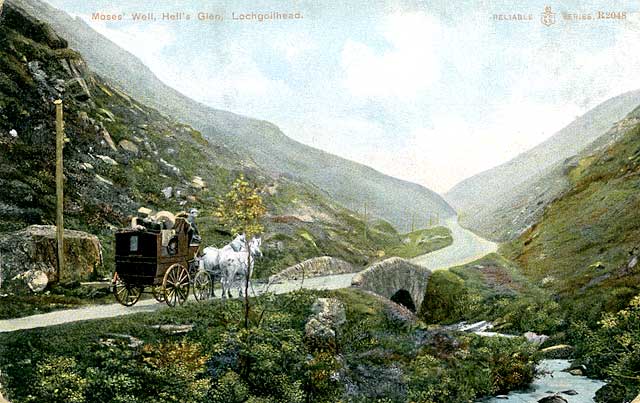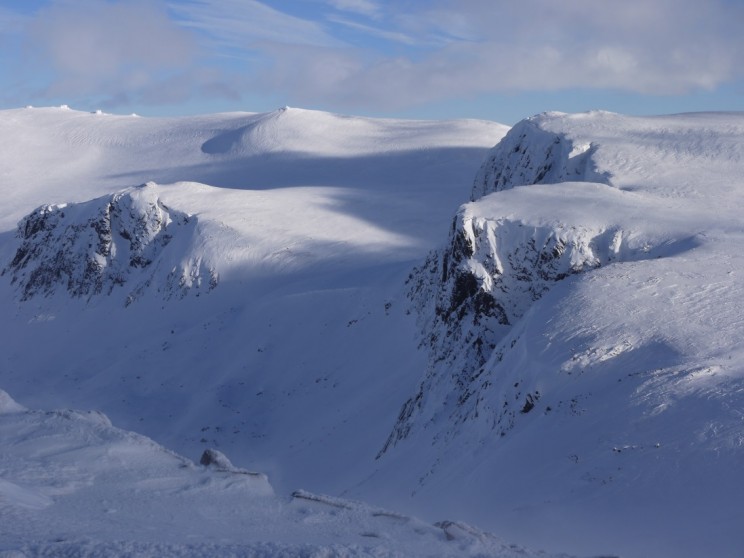
By Jamie Woodward
On 23 September 1840 the wonderfully eccentric Oxford geologist William Buckland (1784–1856) and the Swiss naturalist Louis Agassiz (1809–1873) left Glasgow by stagecoach on a tour of the Scottish Highlands. The old postcard below provides a charming hint of what their horse-drawn jaunt through a tranquil Scottish landscape might have been like in the autumn of 1840. It shows the narrow highway snaking through a rock-strewn Hell’s Glen not far from Loch Fyne. This was the first glacial fieldtrip in Britain. These geological giants were searching for signs of glacial action in the mountains of Scotland and they were not disappointed.

Image from edinphoto.org.uk. Used with permission.
This tour was an especially important milestone in the history of geology because, for the first time, the work of ancient glaciers was reported in a country where glaciers were absent. Agassiz wasted no time in communicating these findings to the geological establishment. The following is an extract from his famous letter that was published in The Scotsman on 7 October 1840 and in The Manchester Guardian a week later:
“… at the foot of Ben Nevis, and in the principal valleys, I discovered the most distinct morains and polished rocky surfaces, just as in the valleys of the Swiss Alps, in the region of existing glaciers ; so that the existence of glaciers in Scotland at earlier periods can no longer be doubted.”
These discoveries initiated new debates about climate change and the extent to which the actions of glaciers had been important in shaping the British landscape. These arguments continued for the rest of the century. In 1840 Buckland and Agassiz had no means of establishing the age of the glaciation because the scientific dating of landscapes and geological deposits only became possible in the next century. They could only state that glaciers had existed at “earlier periods”.
At the end of the previous century, in his Theory of the Earth (1795), Scotsman James Hutton became the first British geologist to suggest that the glaciers of the Alps had once been much more extensive. He set out his ideas on the power of glaciers and proposed that the great granite blocks strewn across the foothills of the Jura had been dumped there by glaciers. This was several decades before Agassiz put forward his own grand glacial theory. Hutton did not speculate about the possibility of glaciers having once been present in the mountains of his homeland.
Following the widespread use of radiocarbon dating in the decades after the Second World War, it was established that the last Scottish glaciers disappeared about 11,000 years ago at the close of the last glacial period. Many of the cirques of upland Britain are now occupied by lakes and peat bogs which began to form soon after the ice disappeared. By radiocarbon dating the oldest organic deposits in these basins, it was possible to establish a minimum age for the last phase of glaciation. A good deal of this work was carried out by Brian Sissons at the University of Edinburgh who published The Evolution of Scotland’s Scenery in 1967.
Geologists now have an array of scientific dating methods to construct timescales for the growth and decay of glaciers. The most recent work in some of the high cirques of the Cairngorms led by Martin Kirkbride of Dundee University has argued that small glaciers may have been present in the Highlands of Scotland during the Little Ice Age – perhaps even as recently as the 18th century. These findings are hot off the press — published in January 2014. Kirkbride’s team employed a relatively new geological dating technique that makes use of the build-up of cosmogenic isotopes in boulders and bedrock exposed at the Earth’s surface.

Photograph from Tarmachan Mountaineering. Used with permission.
So in 2014 we have a new interpretation of parts of the glacial landscape and a debate about the climate of the Scottish mountains during The Little Ice Age. This latest chapter in the study of Scottish glaciation puts glacial ice in some of the highest mountains about 11,000 years later than previously thought. The Scottish uplands receive very heavy snowfalls – the superb photograph of the Cairngorms shows this very clearly – and many snow patches survive until late summer. But could small glaciers have formed in these mountains as recently as The Little Ice Age? Some climate models with cooler summers suggest that they could.
This latest work is controversial and, like the findings of Agassiz and Buckland in 1840, it will be contested in the academic literature. Whatever the outcome of this new glacial debate, it is undoubtedly a delightful notion that only a century or so before Buckland and Agassiz made their famous tour, and when a young James Hutton, the father of modern geology, was beginning to form his ideas about the history of the Earth, a few tiny glaciers may well have been present in his own backyard.
Jamie Woodward is Professor Physical Geography at The University of Manchester. He has published extensively on landscape change and ice age environments. He is especially interested in the mountain landscapes of the Mediterranean and published The Physical Geography of the Mediterranean for OUP in 2009. He is the author of The Ice Age: A Very Short Introduction. He tweets @Jamie_Woodward_ providing a colourful digital companion to The Ice Age VSI.
Jamie Woodward will be appearing at the Oxford Literary Festival on Saturday 29 March 2014 at 1:15 p.m. in the Blackwell’s Marquee to provide a very short introduction to The Ice Age. The event is free to attend.
The Very Short Introductions (VSI) series combines a small format with authoritative analysis and big ideas for hundreds of topic areas. Written by our expert authors, these books can change the way you think about the things that interest you and are the perfect introduction to subjects you previously knew nothing about. Grow your knowledge with OUPblog and the VSI series every Friday, subscribe to Very Short Introductions articles on the OUPblog via email or RSS, and like Very Short Introductions on Facebook.
Subscribe to the OUPblog via email or RSS.
Subscribe to only earth and life sciences articles on the OUPblog via email or RSS.
Image credits: (1) With permission from edinphoto.org.uk (2) With permission from Tarmachan Mountaineering
The post Ice time appeared first on OUPblog.


